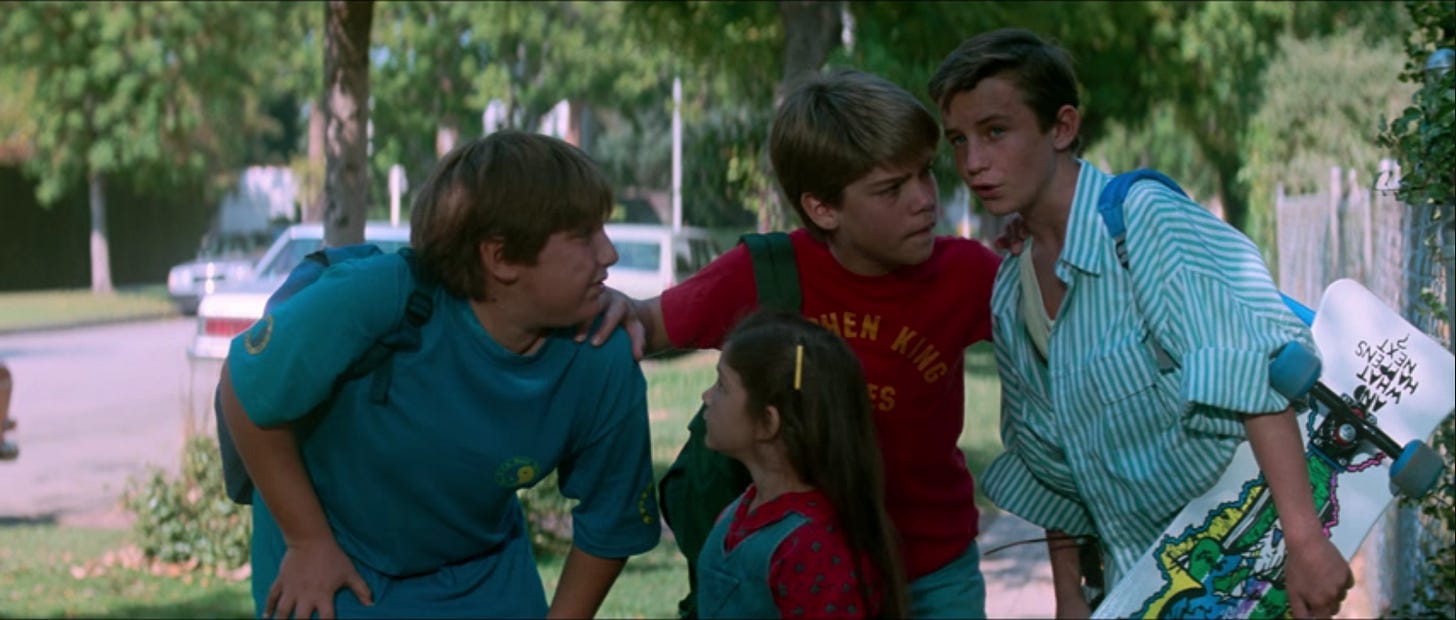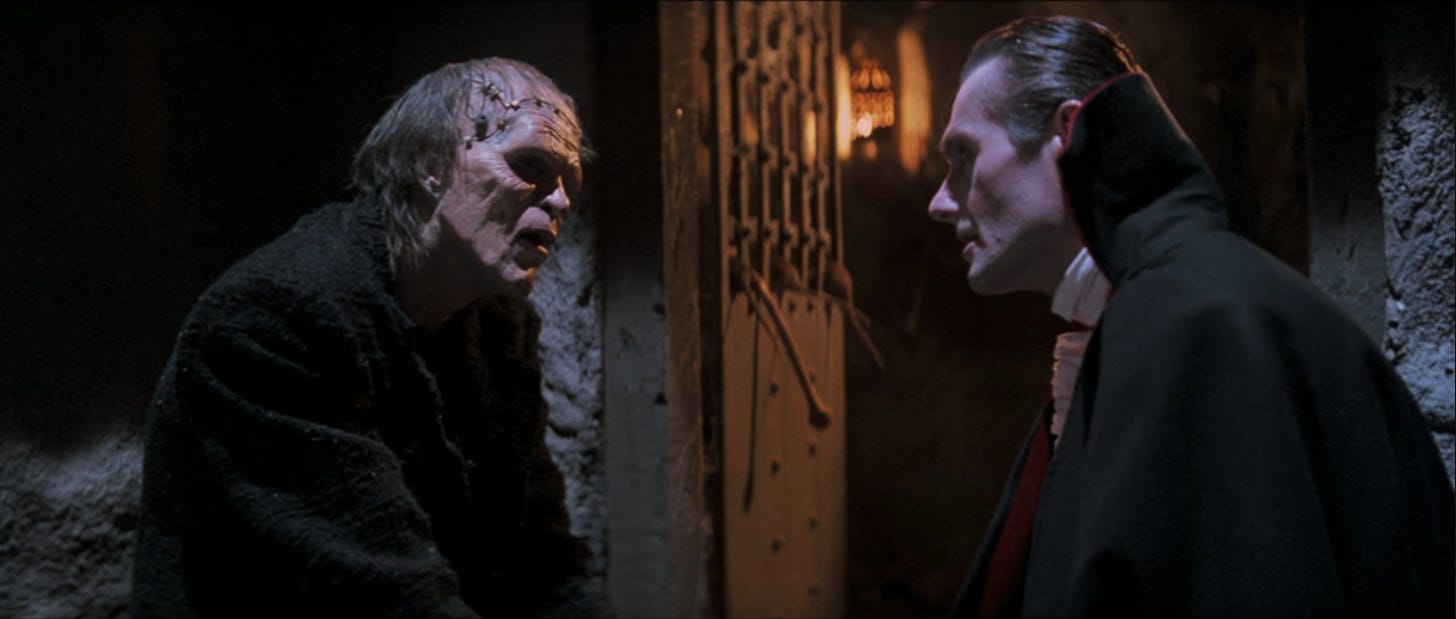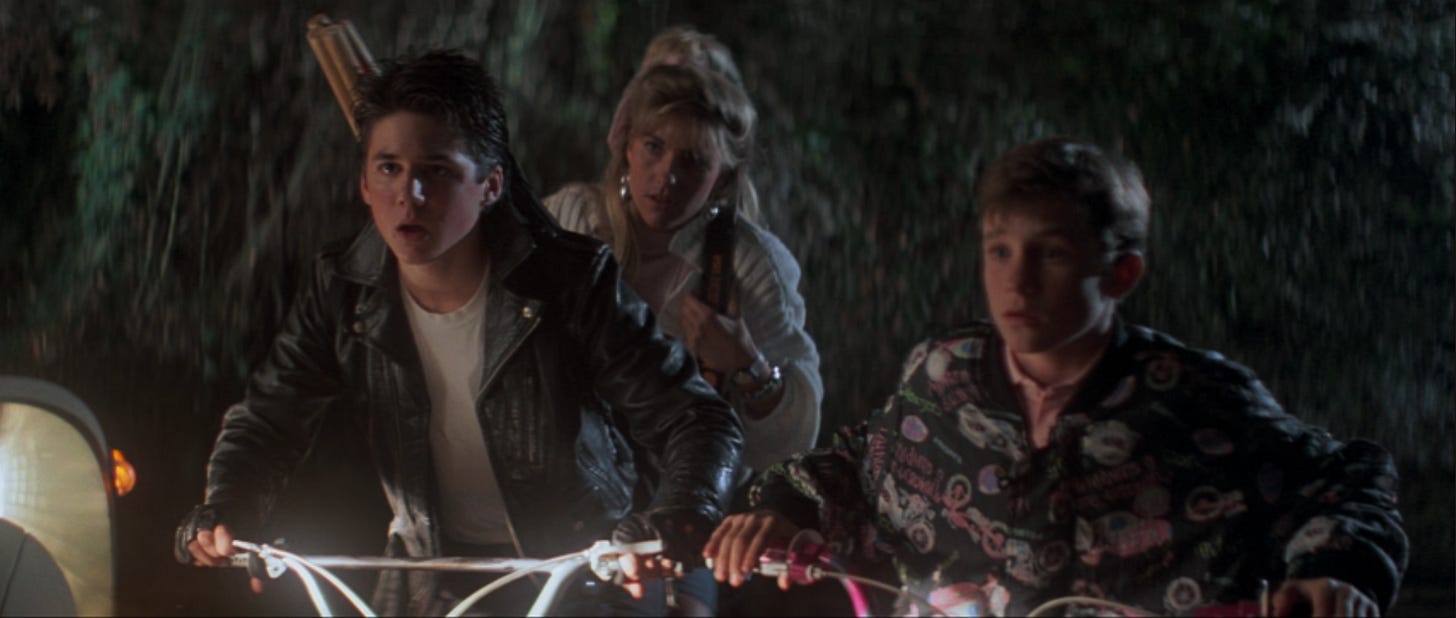Video Days is on summer vacation and idling away the afternoons in our treehouse, craving an adventure. Join us in the month of June for five films combining adolescent spirit and a journey.
THE MONSTER SQUAD (1987) represents the best of the low-tier “Kids on Bikes” movies, a subgenre of science fiction, fantasy or action/ adventure cleared for takeoff after the success of E.T. The Extra Terrestrial (1982). If E.T. occupies the top-tier, the high-tier would be The Goonies (1985) and The Lost Boys (1987). The best of the mid-tier are Explorers (1985) and the greatest “Kids on Bikes” movie ever made in Australia, BMX Bandits (1983). Occupying the low-tier with factory recalls like Mac and Me (1988) is The Monster Squad, a film which has too much talent in its workshop to be mentioned alongside garbage like Mac and Me.
Fred Dekker was born in San Francisco and grew up a fan of two industries within 1930s and ‘40s Hollywood. First were the classic Universal Pictures monster movies. While he did find The Bride of Frankenstein (1935) and Son of Dracula (1943) scary, those featuring Dracula, Frankenstein’s Monster, Wolfman, the Mummy or in 1954, Creature From the Black Lagoon, struck him as having fantastic mystique. Dekker was also a fan of the Our Gang comedies featuring the Little Rascals: Spanky, Alfalfa, Buckwheat, Darla, Froggy, et al. While not a fan of the Three Stooges, Dekker did love Abbott & Costello, a UHF channel in San Francisco running their films Sunday mornings. Abbott and Costello Meet Frankenstein (1948) was a revelation, both funny and scary, Bud & Lou sharing scenes with Bela Lugosi and Lon Chaney Jr. reprising their roles as Dracula and Wolfman completely straight. Rejected by film schools at both USC and UCLA, Dekker graduated as a Bruin with a degree in English. What he wanted to do was make movies and hang out with his friends. He moved in with a buddy from high school named James Cappe who’d graduated as a Trojan. Two more young men obsessed with making movies and hanging out–Robert Reneau and Ryan Rowe–joined them, renting a two-bedroom apartment in Westwood. Living down the street were UCLA alums Shane Black and David Arnott, and another named Ed Solomon. They started calling themselves the “Pad O’ Guys.”
In 1984, several of the guys would rent a house in West Hollywood as their new base. They watched action movies on the VCR, wrote short scripts, and messed around with a camera that belonged to Cappe. Everyone in the Pad O’ Guys started writing screenplays, some filled with jokey, self-referential asides to the producers they hoped would read them. Shane Black had graduated with a degree in theater, but found auditions too intimidating. He was barely old enough to buy a beer when he sold a paranormal thriller he’d authored titled Shadow Company. Black was twenty-two when Warner Bros. took his spec script Lethal Weapon off the market for $250,000. Fred Dekker had thrown his first completed script in the trash, but had shared his second with an English professor while enrolled at UCLA. The instructor took it seriously enough to help Dekker land a literary agent, David Greenblatt of ICM. Dekker was twenty-two when commissioned to write an American-set Godzilla movie for director Steve Miner. Dekker and Miner’s ambitions proved more expensive than Toho Co. was prepared to spend. Dekker had been scribbling an idea for a short film he proposed would be part of an anthology, each of the Pad O’ Guys making a segment. Dekker’s story was about a Vietnam vet who inherits a haunted house.
Conceived as stripped down and very scary, Dekker abandoned his segment, until one of his friends, Ethan Wiley, asked for permission to expand it to a feature-length screenplay. Dekker passed Wiley’s finished script, which had humor and was titled House, to Steve Miner, who wanted to direct it and did, the WGA awarding screenplay credit to Wiley and story credit to Dekker in 1985. Realizing he needed to up his game, Dekker turned his focus to a time travel script about two guys and a girl. Jettisoning the time travel and introducing slugs from outer space that reanimated corpses, Dekker’s agent sent Night of the Creeps to market. Dekker took his time travel material and shot about ten minutes of it as a short film, and TriStar Pictures liked the slug script and Dekker’s demo reel enough to finance and distribute Night of the Creeps with Dekker directing. It was during post-production that the rookie director thought he should line up his next job. In the late winter/ early spring of 1986, Dekker approached Shane Black about collaborating on the script for a horror/ comedy that would introduce the classic Universal monsters to a gang of kids, like the Little Rascals. While Dekker was finishing Night of the Creeps, Black wrote a first draft on his own. Dekker wrote material on his own and the pair would rewrite each other’s work (the only scene they’d craft together would be the kids entering Dracula’s mansion together).
Dekker was a fan of director/ writer/ cinematographer Peter Hyams, particularly Capricorn One (1978) and Hanover Street (1979), the latter of which Dekker thought was under-rated. Meeting with the filmmaker at his office, he recognized Hyams, who’d written and directed the cop thriller Busting (1974) starring Elliott Gould and Robert Blake, shared a sensibility with Shane Black, whose cop thriller Lethal Weapon would soon cast Mel Gibson and Danny Glover as mismatched partners. Black & Dekker pieced together a draft of what they’d titled The Monster Squad, with Dekker attached as director. Hyams agreed to godfather the project as an executive producer, bringing in Jonathan Zimbert, a former assistant who Hyams had promoted to an associate producer on The Star Chamber (1983), 2010 (1984) and Running Scared (1986), to produce. Dekker wanted to use the classic makeup designs Jack Pierce had created for the Universal monsters, just like Abbott and Costello Meet Frankenstein. High on resurrecting the characters of Dracula, Frankenstein’s Monster, Wolfman, Mummy and Gillman, Hyams and Dekker met with Universal executives to pitch their project.
To their amazement, the studio passed, dubious that their classic monsters would generate a dime at the box office. Universal placed so little value on its intellectual property that they accommodated Dekker to make his movie elsewhere, four of the five monsters in the public domain. Hyams took The Monster Squad to Taft-Barish Productions, a joint venture between Taft Motion Pictures and Keith Barish Productions based in Century City, for financing. TriStar Pictures had agreed to distribute ten of Taft-Barish’s upcoming films, to be budgeted between $15-20 million. With the exception of U.S. domestic rights, Taft-Barish would hold onto all other rights, licensing agreements in place with Vestron Video and HBO for videocassette and cable. Their slate of films coming in 1987 looked promising: Michael J. Fox and Joan Jett in the musical drama Light of Day, Jack Nicholson and Meryl Streep in the Depression-era drama Ironweed, Arnold Schwarzenegger in the science fiction/ action film The Running Man. Taft-Barish agreed to finance The Monster Squad at a production budget of $14 million, vice-president Rob Cohen and chairman Keith Barish taking executive producer credits with Hyams. As soon as Fred Dekker finished Night of the Creeps, he started prepping The Monster Squad.
Universal did hold the rights to the makeup design of their monsters, like the flat scalp and neck bolts on Frankenstein’s Monster, or the widow’s peak on Dracula. Makeup effects maestro Stan Winston took on the challenge of making the monsters look different, but recognizable. The next generation of monster builders were working for Stan Winston Studio and would be credited as Head Monster Makers. Tom Woodruff Jr. sculpted the prosthetics for Frankenstein’s Monster. Alec Gillis designed the various bat-like creatures Dracula transformed into. John Rosengrant designed Wolfman. Shane Mahan tackled Mummy. Matt Rose and Steve Wang were responsible for Gillman, played in costume by Woodruff. Shooting commenced October 1986 in Los Angeles. Richland Avenue Elementary in L.A. was used as the exterior for the kids’ school. Many of the neighborhood exteriors were grabbed in Santa Monica, while the treehouse, cemetery and forest scenes were shot thirty miles away in Newhall. Production jumped from Universal Studios for the monster mansion exterior, Warner Bros. Ranch for the outside of the house where club leader Sean (André Gower) lives, while the finale in town square was filmed on the Warner Bros. backlot. Interiors were shot at Culver Studios.
Hoping they had a sleeper hit on their hands, TriStar opened The Monster Squad in mid-August 1987. The film picked up an endorsement from Kevin Thomas, an off-beat critic for the Los Angeles Times, who wrote the movie was “so much fun it makes one wish to be a kid again.” Writing in the New York Times, Vincent Canby was unaffected (“A silly attempt to crossbreed Our Gang comedy with a classic horror film, which usually means that both genres have reached the end of the line.”) Whereas Night of the Creeps has been banished to a limited release and grew a cult following on videocassette and cable, The Monster Squad opened in 1,280 theaters in the U.S. Its commercial performance was as bleak as Dekker’s debut, Stakeout and the new James Bond film The Living Daylights dominating the box office. In its third week of release, a rival “Kids on Bikes” movie with vampires, The Lost Boys, sold more tickets, as did two new films with stronger marketing campaigns, or appeal, or both: Can’t Buy Me Love and No Way Out. As far as the top ten grossing films of any given week, The Monster Squad never crashed the list. Dekker would direct one more feature film, the maligned RoboCop 3, which wrapped production in May 1991 and wouldn’t be released until late 1993 as Orion Pictures was broken up in bankruptcy court. Like Night of the Creeps, a fan base grew up around The Monster Squad. While Ryan Gosling was fulfilling his obligation to promote a big Warner Bros. picture titled Gangster Squad (2013) that appeared headed for failure, he openly joked that he was in it because he thought someone had said Monster Squad.
The Monster Squad is like a cover band that skirts a lawsuit, but struggles to find a voice of its own, or apply quality control. Its best quality is that it seems written, produced and directed by 10-year-olds for 10-year-olds, manufacturing a world bordered by a treehouse, movie monsters, bicycles and hanging out with your friends. Its biggest flaw at the script level is that its monsters are just hanging out too. In a marginally better “Kids on Bikes” movie, Silver Bullet (1985), a werewolf is not only terrorizing a town, but attacks a boy in a wheelchair (Corey Haim). In response, the boy and his uncle (Gary Busey) must destroy the beast. The kids in The Monster Squad don’t need to kill monsters and don’t want to. They’re fans. They might run from Wolfman, Mummy and Gillman, but wouldn’t turn down a group photo. That’s nice for them, but makes for a mushy movie. The action is too convenient, like the amulet to defeat monsters being hidden in the same town that just so happens to have a group of kids who worship monsters. At one point, three women Dracula has abducted somewhere (perhaps in scenes written, shot and cut) are revealed in a closet. Transformed into Dracula’s brides–also off-screen–two are staked in the finale and a third not dealt with at all, as if math problems were too much of a hassle for the boys who made the movie. Picked on by bullies (including Jason Hervey, soon to be cast as the older brother on the TV series The Wonder Years), the kids conveniently fall under the protection of an older kid, whose participation in their club when he’s clearly more interested in girls is never explained.
Running 82 minutes with credits, the script either never had any kitchen sink scenes written, or they were cut in favor of the special effects. The work by Stan Winston Studio is excellent, Wolfman the most compelling character. Much of the delight there is its alter-ego, played with gusto by character actor Jonathan Gries, whose work ranges from the mysterious post-grad Laszlo Hollyfield in Real Genius (1985) to Uncle Rico in Napoleon Dynamite (2004). Gries brings to mind a good-looking Chris Elliott and absolutely warranted more screen time. The kids give pedestrian kid performances, but they aren’t the problem, their script and director is. The Monster Squad reports to work so nonchalantly that it makes The Goonies better by association. None of its kids are given quirks or distinguished from each other, looking, speaking and acting the same. Without extraordinary actors or chemistry to paper over the weaknesses in the script, Fred Dekker gets in over his skis as a director. There are two ways it makes sense for kids to meet movie monsters. Those classic characters could have stepped down from a movie screen, like The Purple Rose of Cairo (1985), or the kids jumped into a movie, like Last Action Hero (1993), which Shane Black & David Arnott would rewrite on commission. Either would’ve been economical if the movie-within-a-movie had been a Universal horror picture, and only required suspension of disbelief once. As is, the film is one contrivance after another. With a rousing musical score by Bruce Broughton and visual effects by Boss Film Corp, The Monster Squad has production value that exploitation fare like Night of the Comet (1984) might envy, but it’s nowhere near as entertaining, Black & Dekker only going as far as politely roasting the movies of their childhood instead of creating their own act.
Video rental category: Fantasy
Special interest: Kids on Bikes











